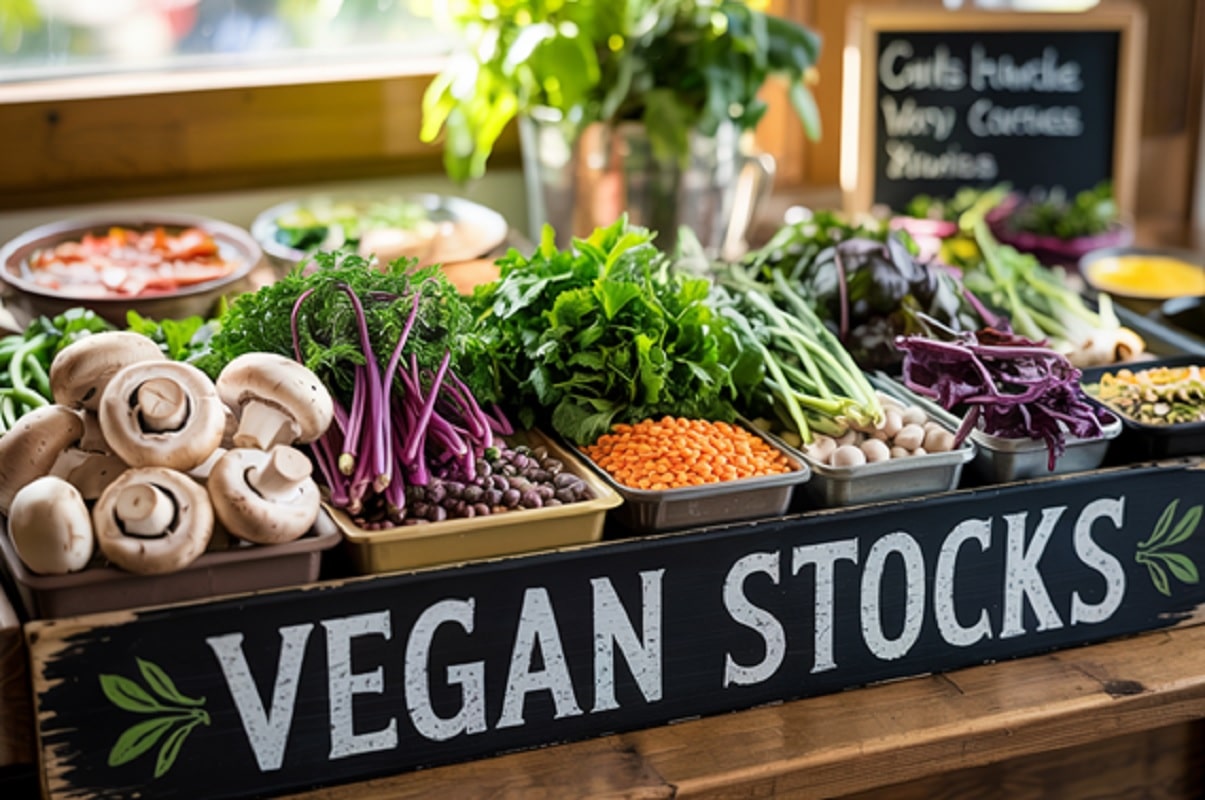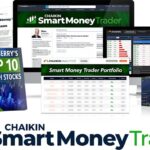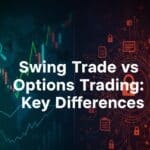People aren’t backtracking on plant-based eating. The real story? It’s gone mainstream. Even fast-food giants like McDonald’s and Pizza Hut are shoving vegan options onto menus, not because they’ve suddenly grown consciences, but because the money’s there. Millennials and Gen Z drive this, but let’s be real: everyone’s staring down inflation, and lentils are cheaper than lamb chops.
This report analyzes this dynamic market and five US-listed stocks poised to potentially benefit in 2025: Ingredion (INGR), Beyond Meat (BYND), Oatly (OTLY), Laird Superfood (LSF), and SunOpta (STKL). Success will hinge on managing price sensitivity, achieving profitability, effective innovation, and navigating competitive pressures.
The Booming US Vegan Market Landscape: Understanding the Terrain
The US vegan and plant-based food sector continues its expansion, driven by shifting consumer values and technology.
Market Size and Growth: The US retail market hit $8.1 billion in 2024, up from $3.9 billion in 2017. Forecasts remain robust, with projections suggesting continued double-digit CAGR growth through 2030-2035, potentially reaching towards $27 billion (US) or over $80 billion (Global) depending on the source. The alternative protein market, a core component, is also forecast to grow significantly.
Key Growth Drivers: Demand is fueled by:
- Health Focus: Increased awareness of benefits like lower saturated fat and reduced disease risk.
- Sustainability: Growing concern over animal agriculture’s environmental impact.
- Ethical Concerns: Animal welfare remains a key motivator.
- Taste & Tech: Innovation in ingredients, texturization, and fermentation improves product appeal.
- Dietary Flexibility: Rise of vegan, vegetarian, and especially flexitarian diets expands the market.
Consumer Behavior & Competition: Plant-based is mainstream (59% household penetration in 2024), with taste/texture concerns diminishing.
However, price remains a major barrier, often carrying a premium. Consumers seek “value and values.” The market is highly competitive, with large CPGs (Nestle, Danone, Tyson, etc.) entering via acquisitions or new lines alongside rapidly growing private label offerings from retailers like Kroger and Target pressuring dedicated brands.
Continuous innovation is crucial. Price sensitivity particularly benefits private labels , forcing branded players to justify premiums through superior quality or innovation.
Top 5 US Vegan Stock Recommendations for 2025: A Diverse Menu
These five US-listed stocks offer distinct ways to participate in the vegan trend, catering to different risk profiles.
Ingredion Incorporated (INGR): The Foundational Provider
- Snapshot: Major global ingredient supplier, transforming crops into value-added components (plant proteins, starches, sweeteners) crucial for the vegan sector. Strong focus on sustainability.
- Financials: ~$7.4B annual sales (2024). Reported Q4/FY24 results Feb 4, 2025; Q1 2025 results expected May 6, 2025. Focus on managing commodity costs and efficiency.
- Strategy: Leverage plant-based ingredient expertise , implement “Cost2Compete” program , prioritize organic investment, dividends, and share buybacks ($216M in 2024).
- Valuation/Rationale/Risk: Relatively stable, lower-risk B2B play offering broad exposure to ingredient demand, insulated from consumer brand wars. Offers dividend; FY25 adj. EPS outlook $10.75-$11.55. Risks: commodity price volatility, customer dependence, execution risk.
- Recommendation: Suitable for stable exposure and dividend income, lower volatility than pure-plays.
Beyond Meat, Inc. (BYND): The High-Profile Turnaround Candidate
- Snapshot: Pioneer in plant-based meat alternatives with significant brand recognition. Pursued high-profile foodservice partnerships.
- Financials: Q4/FY24 results (Feb 26, 2025) showed FY24 revenue down 4.9% ($326.5M) but improving gross margin (12.8% FY24 vs -24.1% FY23). Continues to post net losses and faces cash burn challenges.
- Strategy: 2025 goals: comparable YoY revenue ($320M-$335M), ~20% gross margin, reduced operating expenses ($160M-$180M), strengthen balance sheet, targeting run-rate EBITDA-positive ops by end-2026. Involves restructuring (workforce cuts, suspending China ops ) and new product launches (Beyond IV ).
- Valuation/Rationale/Risk: High-risk/reward turnaround. Rationale hinges on brand strength, potential margin recovery, and innovation success. Risks: intense competition, achieving profitability/positive cash flow, negative consumer perceptions/price premiums , high execution risk on complex strategy , potential delisting. Balancing cost cuts with needed investment is critical.
- Recommendation: Only for high-risk tolerant investors believing in the brand and management’s turnaround ability.
Oatly Group AB (OTLY): The Oat Milk Leader Seeking Profitability
- Snapshot: World’s original and largest oat drink company with strong brand recognition via distinctive marketing.
- Financials: Q4/FY24 results (Feb 12, 2025) showed revenue growth (FY24 +5.1% to $823M). Gross margin improved significantly (28.8% Q4, +540 bps YoY). Adjusted EBITDA loss narrowed (Q4 -$6.1M vs -$19.2M YoY) , but remains unprofitable net. Q1 2025 results expected ~Apr 30, 2025.
- Strategy: Primary 2025 goal: first full year of profitable growth (targeting adj. EBITDA $5M-$15M). Involves “asset-light” strategy (closing Singapore facility, halting China construction ). Guides 2-4% constant currency revenue growth (impacted by customer sourcing change). Low capex ($30M-$35M).
- Valuation/Rationale/Risk: High-risk/reward turnaround. Case rests on brand equity, category leadership, operational improvements, and 2025 profitability plan. Risks: achieving/sustaining profitability, competition, execution risk (asset-light strategy), potential need for capital. Asset-light shift prioritizes near-term finances over potentially faster expansion.
- Recommendation: Suitable for risk-tolerant investors believing in oat milk, Oatly’s brand, and management’s restructuring plan.
Laird Superfood, Inc. (LSF): The Small-Cap Growth Story
- Snapshot: Produces plant-based, functional foods (vegan creamers, beverages, snacks) targeting health-conscious consumers. Recently launched “The Market Place” online platform.
- Financials: Q4/FY24 results (Feb 26, 2025) showed strong momentum: FY24 net sales +27% ($43.3M), Q4 +26% ($11.6M). Gross margin improved dramatically (FY24 40.9% vs 30.1% FY23) via sourcing/co-packing shift. Net loss narrowed significantly ($1.8M FY24 vs $10.2M FY23). Achieved positive operating cash flow ($0.9M) FY24.
- Strategy: Targets 20-25% net sales growth in 2025, high 30s gross margin, adjusted EBITDA breakeven. Growth drivers: successful restructuring (variable-cost co-manufacturing ), strong e-commerce (Amazon +32% FY24 ), expanding wholesale (Kroger, Safeway wins ), innovation.
- Valuation/Rationale/Risk: Compelling small-cap turnaround growth narrative. Rationale: revenue acceleration, margin expansion, strong e-commerce, growing retail, near breakeven. Risks: small-cap volatility/liquidity, co-packer dependence, sustaining growth, achieving consistent profitability, competition, potential supply issues. Co-packing shift de-risks operations but shifts risk to partner management.
- Recommendation: Appeals to investors seeking high-growth potential in small-cap vegan/functional foods, tolerant of higher volatility.
SunOpta Inc. (STKL): The Private Label Powerhouse
- Snapshot: Key player, primarily co-manufacturing and supplying private label plant-based beverages (soy, almond, oat milk), broths, fruit snacks. Holds significant share in niches like shelf-stable plant-based milks (~70% ).
- Financials: Q4/FY24 results (Feb 26, 2025) showed solid growth: Q4 revenue +8.9% ($193.9M) on 12.8% volume growth. FY24 revenue $724M. Adjusted EBITDA +20% in Q4 ($26.1M), margin 13.5%. Generated $52.3M operating cash flow FY24.
- Strategy: Positive 2025 outlook: revenue growth 7-11% ($775M-$805M), adjusted EBITDA growth 9-16% ($97M-$103M). Focus: growth via co-man/private label, productivity, profitability, free cash flow generation, deleveraging (major capex complete). Leverage scalable network.
- Valuation/Rationale/Risk: Offers exposure via stable B2B model. Rationale: strong volume growth, improving profitability, key supplier role (esp. private label), clear guidance, focus on cash flow/debt reduction. Risks: customer concentration, co-man competition, input costs. Strategic position aligns well with private label growth trend.
- Recommendation: Suitable for investors seeking growth via B2B model, potentially more stable than pure-plays. Role supporting private label growth is key.
Key Investment Risks and Considerations
Investing requires weighing sector-wide and company-specific risks.
1. Sector-Wide Challenges:
- Path to Profitability: Many pure-play brands struggle due to high R&D/marketing costs and scaling issues.
- Intense Competition: Pressure from large CPGs and lower-priced private labels.
- Consumer Hurdles: Taste, texture, and price parity remain critical for broad adoption.
- Macroeconomic Factors: Inflation can raise costs and dampen demand for premium products.
- Supply Chain & Regulatory Risks: Input cost volatility, complex global chains, and evolving labeling rules pose challenges.
2. Company-Specific Risks: Summarized in individual analyses above.
3. Alternative Exposure: Vegan ETFs: For diversification, consider ETFs like VEGN or EATV , but scrutinize holdings as some (like VEGN) are tech-heavy, diluting direct food exposure.
Concluding Remarks & Forward Outlook
The US vegan food market offers compelling long-term potential, driven by consumer shifts towards health, sustainability, and ethics.
Ingredion, Beyond Meat, Oatly, Laird Superfood, and SunOpta provide diverse investment avenues for 2025.
INGR and STKL offer stable B2B exposure; BYND and OTLY are higher-risk turnaround plays; LSF is a small-cap growth story.
Careful stock selection is crucial, assessing financials, competitive position, strategy, execution, and valuation. Competitive pressures and achieving mainstream taste/price parity remain key challenges. Monitoring innovation, consumer trends, costs, and regulations is vital for navigating this dynamic market.
Frequently Asked Questions (FAQ)
Why consider investing in vegan stocks?
The plant-based food market is experiencing significant growth driven by increasing consumer awareness of health benefits, environmental sustainability, and ethical considerations regarding animal welfare. Technological advancements are also continuously improving the taste and texture of plant-based alternatives, making them more appealing to a wider audience.
What are the biggest risks when investing in this sector?
Key risks include intense competition from large, established food companies launching their own lines and the rapid growth of lower-priced private label options. Many pure-play vegan companies also face challenges in achieving sustained profitability due to high operating costs. Additionally, consumer price sensitivity remains a hurdle, as plant-based products often carry a premium.
How can smaller vegan companies compete against large food corporations?
Smaller companies often focus on innovation, building strong brand identities within specific niches (like Laird Superfood’s functional products or Oatly’s oat milk leadership ), and agility. Some also act as suppliers or co-manufacturers for larger entities, benefiting from overall sector growth (like SunOpta ).
Are there other ways to invest in the vegan trend besides individual stocks?
Yes, Exchange Traded Funds (ETFs) like the US Vegan Climate ETF (VEGN) and the VegTech Plant-based Innovation & Climate ETF (EATV) offer diversified exposure to companies aligned with vegan or climate themes. However, it’s important to review the specific holdings, as some ETFs may include companies outside the food sector.

































